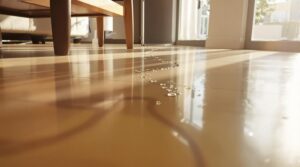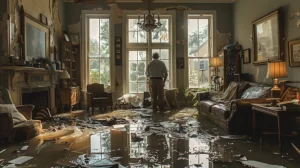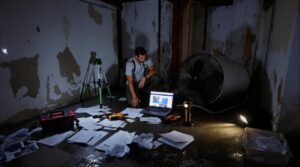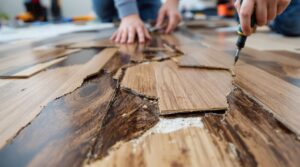Water-damaged subfloor repair requires systematic inspection and professional moisture detection to determine the full extent of deterioration. The process involves marking damaged sections, cutting along floor joists with a circular saw, and removing compromised materials with a pry bar. After thorough drying with dehumidifiers and fans, new subflooring installation demands proper adhesive application, precise panel alignment, and consistent spacing. Proper documentation and expert consultation can maximize insurance claim outcomes when tackling substantial repairs.
Key Takeaways
- Thoroughly inspect and mark damaged areas, then use moisture detection tools to determine the full extent of water damage.
- Cut damaged sections with a circular saw set to one-inch depth and remove carefully with a pry bar.
- Dry the affected area completely using dehumidifiers and fans before installing new subflooring materials.
- Apply adhesive to floor joists and install new plywood panels with 1/8-inch gaps, staggering rows for stability.
- Conduct final inspection for levelness and proper fastening, ensuring all panels are securely attached to joists.
Identifying and Assessing Water Damage in Your Subfloor
Proper identification of water-damaged subfloors is essential for maintaining structural integrity and preventing costly repairs.
Key water damage indicators include warping or loose sections in hardwood and tile floors, bubbling in linoleum, and lifting in laminate flooring. Musty odors and visible mold growth also signal potential subfloor deterioration. Early detection through professional inspection helps prevent more serious structural problems down the line.
Professional moisture detection techniques involve examining the subfloor from basement.
Removing and Cleaning Damaged Subfloor Areas
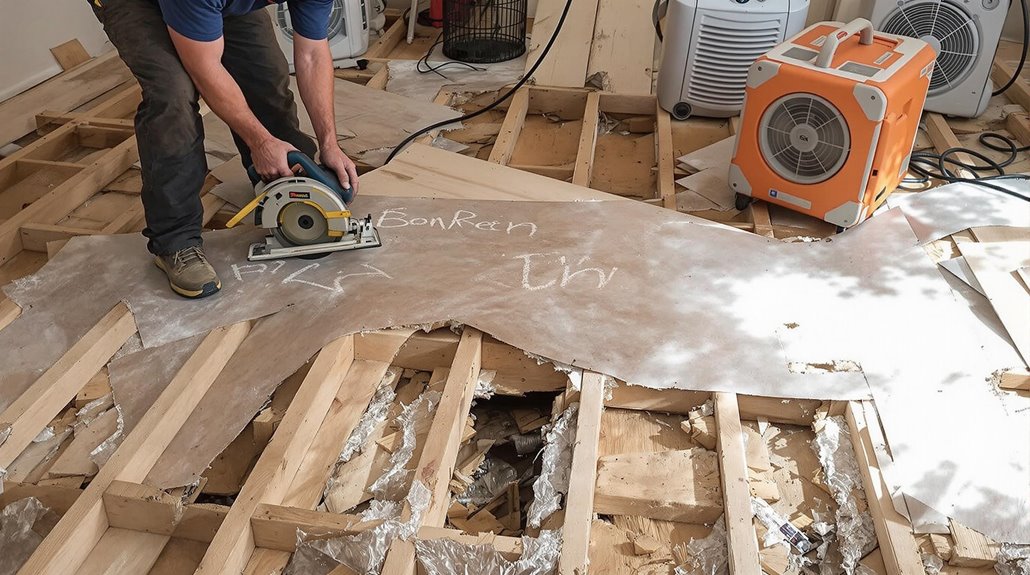
Tackling water-damaged subfloor removal requires careful preparation and systematic execution to prevent further structural damage.
Initial subfloor inspection and moisture detection help determine the precise extent of deterioration before work begins. After marking damaged areas with chalk and locating floor joists, workers must remove baseboards and existing flooring to access the affected sections.
Using a circular saw set to one-inch depth, damaged sections should be cut along the marked lines, followed by careful removal with a pry bar. A detailed inspection for any lingering contaminants should be performed before proceeding with repairs.
The area must then be thoroughly dried using dehumidifiers, fans, and proper ventilation. All wet materials, including vapor barriers and insulation, should be removed from beneath the subfloor.
Complete drying is vital before installing new materials to prevent future moisture-related issues and guarantee structural integrity.
Essential Tools and Materials for Subfloor Repair
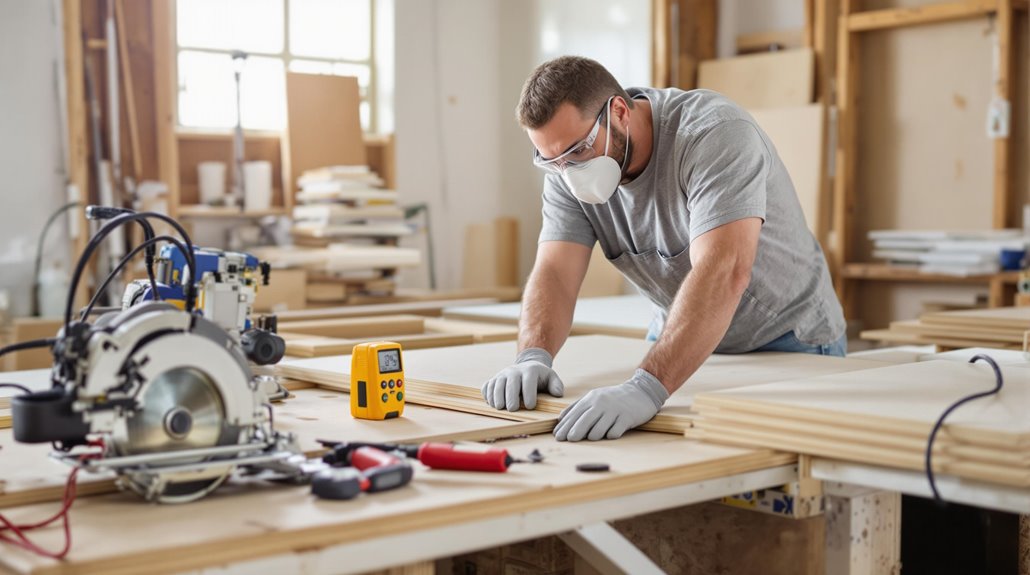
Successfully repairing water-damaged subfloor requires an extensive set of specialized tools and materials. When implementing subfloor repair techniques, professionals must gather both cutting tools and safety equipment before beginning work. Essential safety gear, including safety glasses, gloves, and dust masks, protects workers from common jobsite hazards. A reliable moisture meter helps determine the extent of water penetration before starting repairs.
| Category | Essential Items |
|---|---|
| Cutting Tools | Circular saw, reciprocating saw, drill |
| Safety Equipment | Safety glasses, dust mask, gloves |
| Materials | Plywood sheets, moisture barrier, screws |
The materials needed fall into two main categories: structural components and finishing materials. Structural materials include plywood sheets, cement board, and moisture barriers, while finishing materials encompass baseboards, thresholds, and appropriate sealants. Having these items readily available guarantees efficient completion of the repair process while maintaining safety standards.
Step-by-Step Guide to Installing New Subflooring
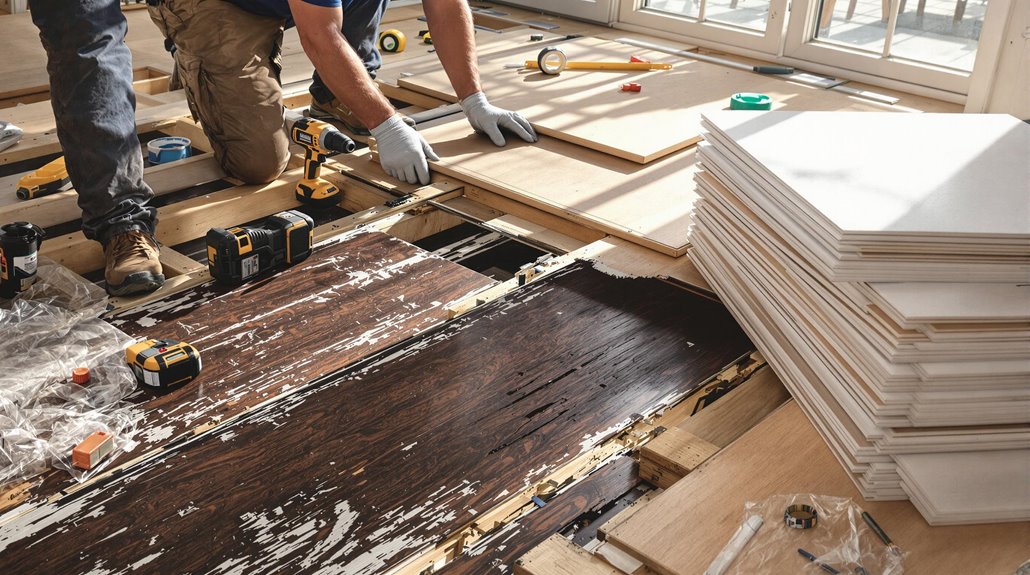
With all necessary tools and materials in place, the installation of new subflooring requires meticulous attention to detail and adherence to building codes. The process begins by snapping reference lines to guarantee proper alignment and applying high-quality adhesive to the joists.
Proper subfloor installation techniques involve laying the first row of panels along the marked lines, guaranteeing secure fastening to the joists. The second row should be staggered by half a panel length to enhance structural stability.
Each subsequent row requires careful application of adhesive and proper fastening, maintaining a consistent 1/8-inch gap between panels. When implementing various subfloor material options, installers must tap panels together using a scrap piece and sledgehammer to achieve tight connections at tongue-and-groove joints.
Final inspection guarantees levelness and proper fastening before proceeding with underlayment installation.
Preventing Future Subfloor Water Damage
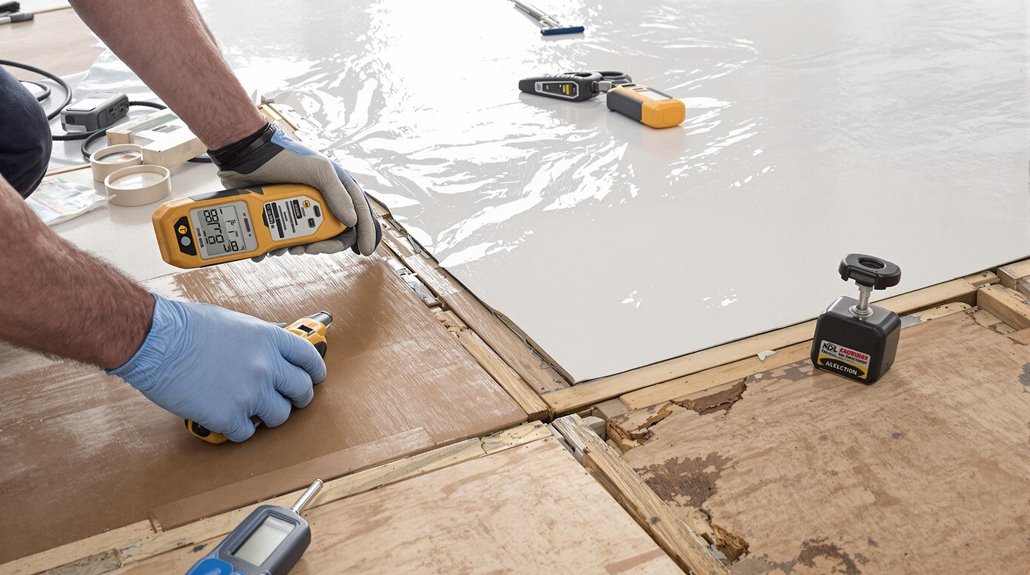
Because water damage can compromise the structural integrity of subflooring, implementing thorough preventive measures remains crucial for long-term floor protection.
Regular inspections of roofing, plumbing systems, and foundation components help identify potential water intrusion points before considerable damage occurs.
Advanced waterproofing techniques include installing appropriate underlayment with vapor retarders and utilizing specialized products like Schluter Ditra systems for moisture prevention.
Professional-grade liquid membranes and fabric reinforcement at critical joints provide additional protection against water penetration.
Installing water detection systems and sump pumps in high-risk areas offers early warning of potential problems.
Proper moisture measurements before, during, and after flooring installation, combined with correct material selection for specific environments, help guarantee lasting subfloor protection.
Regular maintenance and prompt attention to leaks notably reduce the risk of future water damage.
The Benefits Of Consulting A Public Adjuster
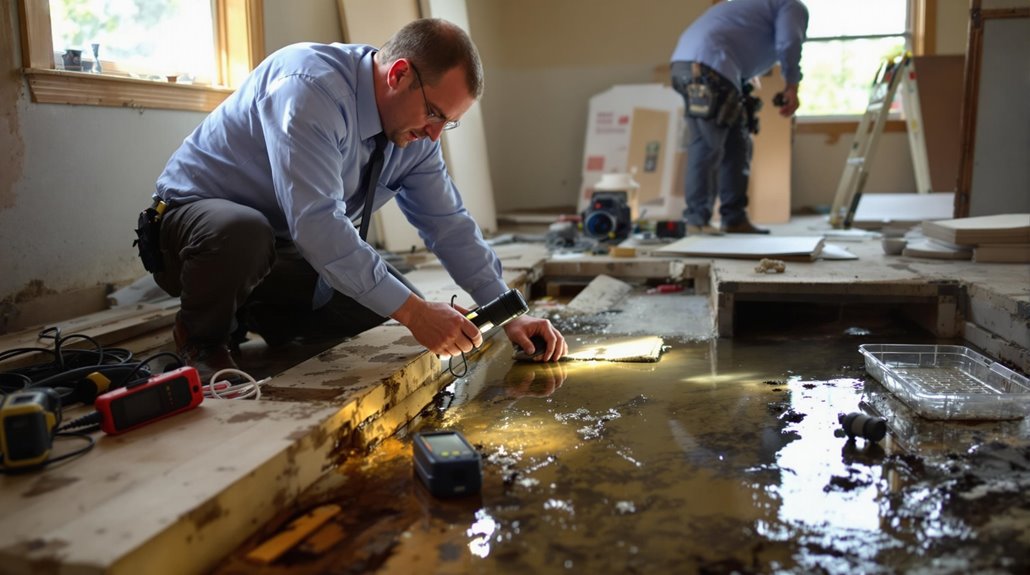
When dealing with water-damaged subfloors, consulting a public adjuster can greatly improve insurance claim outcomes through their expert assessment and documentation capabilities.
Public adjusters provide objective evaluations of damage using specialized equipment, while managing all aspects of the claims process to guarantee proper coverage of repair costs.
Statistical data indicates that professionally-adjusted claims result in settlements averaging 574% higher than those handled directly by property owners, making their services particularly valuable for extensive subfloor water damage situations.
For optimal results, homeowners should engage public adjuster services immediately after discovering water damage to ensure thorough documentation of losses and prevent complications in the claims process.
Expertise In Insurance Claims
Professional public adjusters offer invaluable expertise in managing complex insurance claims for water-damaged subfloors. They possess deep knowledge of insurance policy terms and can effectively prevent claim denial through proper documentation and negotiation.
These specialists understand the intricate details of coverage limitations and exclusions, ensuring policyholders receive fair compensation for their damaged property.
- Conducts thorough assessments of water-damaged subfloors to document extent of damage
- Interprets complex policy language to identify applicable coverage and benefits
- Manages all documentation requirements, including moisture readings and structural analysis
- Negotiates with insurance carriers to secure maximum settlement for subfloor repairs
Their expertise streamlines the claims process, allowing property owners to focus on restoration while ensuring compliance with policy requirements and building codes.
This professional guidance often results in more favorable claim outcomes and faster repair approvals.
Working on a contingency fee basis, public adjusters typically charge 5-20% of the final settlement amount, making their services accessible to most property owners.
Objective Damage Assessment
Securing an objective damage assessment through a public adjuster provides property owners with essential insights into the true extent of subfloor water damage.
Through advanced moisture detection tools and thermal imaging technology, adjusters identify both visible deterioration and concealed issues that might otherwise go unnoticed.
Professional damage assessment encompasses extensive documentation of all affected areas, including moisture seepage patterns and potential mold growth beneath flooring materials.
This thorough evaluation guarantees that the full scope of restoration requirements is accurately captured for insurance claims purposes.
Adjusters utilize specialized equipment to measure moisture levels and detect hidden damage that could compromise structural integrity.
Their expertise helps property owners understand the complete impact of water damage while guaranteeing that all necessary repairs are properly documented for maximum insurance coverage.
Unlike insurance adjusters who may prioritize company interests, public adjuster advocacy ensures policyholders receive fair compensation that covers all necessary subfloor repairs.
Streamlined Claim Process
A streamlined insurance claims process emerges as one of the primary advantages of collaborating with a public adjuster for water-damaged subfloor repairs. These professionals efficiently manage the entire claim process while guaranteeing property owners receive fair compensation for their water damage repairs.
- Documentation gathering and submission, including detailed assessments of subfloor water damage
- Expert communication handling with insurance carriers to expedite claim resolution
- Coordination of professional inspections and damage evaluations
- Management of paperwork and administrative requirements to prevent delays
Public adjusters navigate complex insurance procedures with precision, leveraging their expertise to accelerate claim settlements. Their understanding of insurance terminology, regulations, and company-specific requirements helps avoid common pitfalls that could otherwise delay the repair process.
This professional guidance guarantees property owners can focus on restoration while maintaining compliance with insurance protocols. Working with a public adjuster can lead to higher settlement amounts through their skilled negotiation tactics and comprehensive claim management approach.
Higher Claim Payouts & Settlements
When property owners consult public adjusters for water-damaged subfloor claims, they consistently achieve higher settlement amounts compared to handling claims independently. Through extensive damage assessments and strategic claim negotiation strategies, public adjusters leverage their expertise to identify all compensable losses under the policy terms. Independent repair estimates help policyholders provide competitive figures to strengthen their negotiation position with insurance companies.
| Benefit Category | Impact on Settlement |
|---|---|
| Documentation | Complete evidence collection and organization |
| Policy Analysis | Thorough interpretation of coverage terms |
| Negotiation
About The Public Claims Adjusters Network (PCAN)
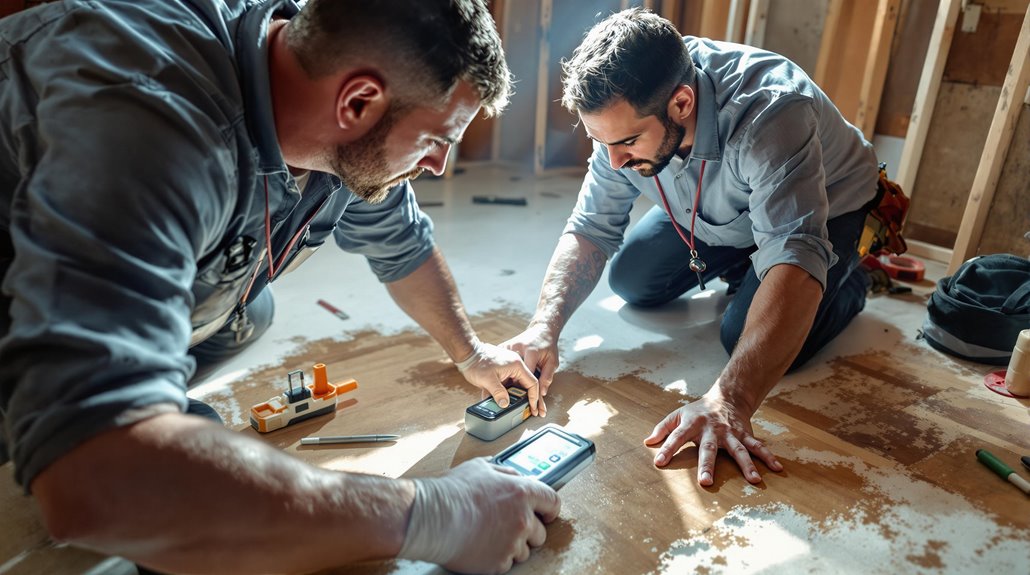
The Public Claims Adjusters Network (PCAN) operates as a nationwide coalition of licensed professionals specializing in insurance claim management and policyholder advocacy.
With public adjuster advantages including detailed damage assessment and expert claims negotiation strategies, PCAN delivers superior outcomes for property owners facing water-damaged subfloor challenges.
- Licensed adjusters conduct thorough structural evaluations and moisture assessments
- Professional teams interpret policy coverage and document damage extensively
- Experienced negotiators interface directly with insurance carriers
- Certified experts oversee repair project management and contractor coordination
PCAN's international presence and expertise in both residential and commercial claims guarantees policyholders receive maximum settlement value.
Their systematic approach combines technical knowledge with regulatory compliance, facilitating efficient claim resolution while maintaining rigorous documentation standards throughout the restoration process.
Frequently Asked Questions
Can I Repair a Water-Damaged Subfloor Without Removing the Existing Flooring?
Proper assessment and repair of water-damaged subfloor requires removal of existing flooring to evaluate damage extent, guarantee complete drying, and execute structural repairs according to building safety standards.
How Long Should I Wait After Drying Before Installing New Subflooring?
Like a freshly baked cake needs cooling, subfloors require proper drying time. After moisture readings confirm complete dryness (typically 2-4 days), installers should wait 24 additional hours before new subfloor installation.
Will My Homeowner's Insurance Cover Subfloor Repairs From Appliance Leaks?
Homeowner's insurance coverage typically includes subfloor repairs caused by sudden, accidental appliance leaks, subject to policy terms and deductibles. Gradual damage or maintenance-related issues may be excluded from coverage.
What Type of Wood Is Best for Subfloor Replacement?
Hard as nails, exterior-grade plywood stands as the gold standard for subfloor replacement. Among engineered wood options, it offers superior structural integrity, moisture resistance, and long-term durability.
Can I Live in My House While Subfloor Repairs Are Being Done?
Temporary living arrangements are recommended during subfloor repairs due to safety concerns, dust exposure, and potential health risks. Extended repairs may require relocation until completion and professional clearance.
References
- https://lpcorp.com/blog/how-to-repair-a-water-damaged-subfloor
- https://uintadisastersolutions.com/blog/how-to-fix-a-water-damaged-subfloor
- https://www.youtube.com/watch?v=qwnWGPp6y4A
- https://www.1tomplumber.com/how-to-fix-a-water-damaged-subfloor/
- https://dryforcecorp.com/how-to-fix-subfloors-with-severe-water-damage/
- https://www.baycrawlspace.com/what-to-do-about-water-damaged-subfloor/
- https://www.truesouthhomeinspection.com/signs-your-subfloor-may-be-incorrectly-installed-or-damaged/
- https://www.bobvila.com/articles/signs-of-water-damage-under-floor/
- https://academyhouseleveling.com/top-3-indicators-of-damaged-subflooring-in-your-home/
- https://www.servicemasterrestore.com/servicemaster-assured-cleaning/why-us/blog/2023/december/7-tips-to-save-a-flood-damaged-floor/

